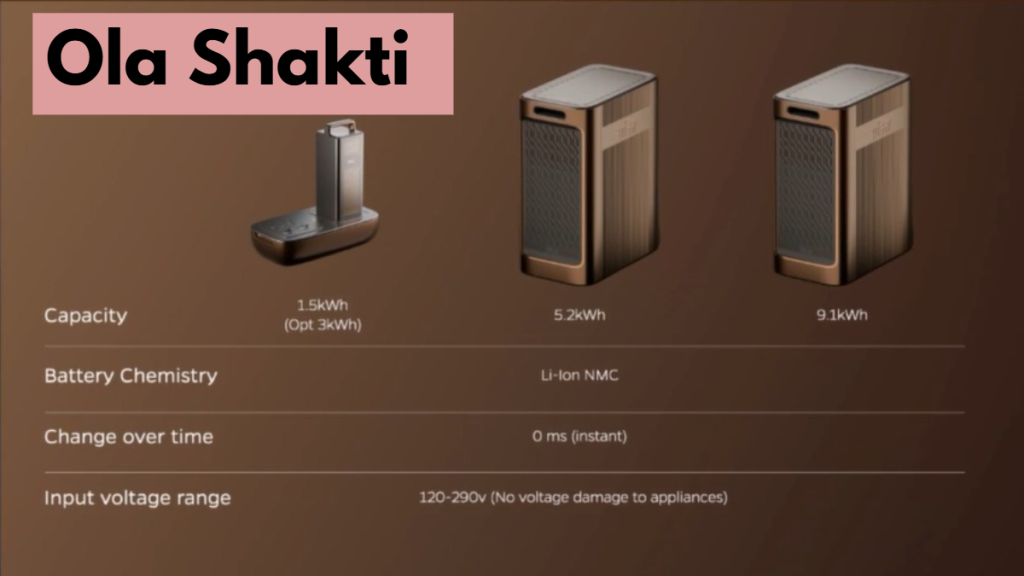Ola Electric Expands into Energy Storage with Launch of ‘Ola Shakti’
Ola Electric has entered the energy storage market with the launch of ‘Ola Shakti.’ After transforming India’s EV landscape, the company now aims to power the clean energy revolution. Ola Shakti focuses on battery energy storage systems (BESS) to store renewable power efficiently, linking EVs, charging networks, and the grid. This move marks Ola’s shift from an electric vehicle maker to a full-fledged energy technology company driving India’s sustainable future.
Ola Electric’s Bold Leap into Energy Storage
Ola Electric, best known for its electric two-wheelers and charging infrastructure, has announced the launch of Ola Shakti, a division focused on energy storage solutions. With this strategic pivot, Ola Electric aims to become a player not only in mobility but also in the clean energy ecosystem.
Energy storage is a critical component in the transition toward renewable power. Batteries help smooth out the intermittent nature of solar and wind, ensuring a reliable supply. For a mobility company like Ola Electric to stake its claim here signals both ambition and foresight.
What Is Ola Shakti?
Ola Shakti is Ola Electric’s corporate arm dedicated to developing battery energy storage systems (BESS) for grid-scale, commercial, and residential usage. The business intends to manufacture modular battery packs, deploy energy storage assets, and offer integrated solutions combining generation, storage, and dispatch.
Key features of Ola Shakti include:
- Modular Battery Technology: Scalable battery packs that can expand capacity as required.
- Smart Energy Management: Software-driven systems will oversee charging, discharging, predictive maintenance, and demand response.
- Integrated Deployment: Coupled with solar or other renewables, Ola Shakti’s systems can deliver end-to-end clean energy solutions.
- Grid Services: The energy storage assets may provide frequency regulation, peak shaving, and other grid stability services.
Through Ola Shakti, Ola Electric aims to leverage its battery R&D capabilities and scale to become a holistic energy-tech company rather than just a mobility OEM.

Strategic Rationale Behind the Move
1. Vertical Integration and Control
By adding energy storage to its portfolio, Ola Electric will control more of the value chain: from battery development to deployment and energy dispatch. This vertical integration could improve margins and create synergies between its mobility and energy divisions.
2. Diversification Against Market Risks
Electric vehicle (EV) markets are intensely competitive and dependent on subsidies, regulations, and infrastructure. Energy storage provides a parallel line of business that can generate income through grid services, solar integrations, and commercial contracts.
3. Capitalizing on Renewable Growth
India and many global markets are aggressively scaling renewables. Government programs such as India’s National Solar Mission and state-level renewable energy policies demand energy storage systems at scale. Ola Shakti positions Ola Electric to ride this wave.
4. Investor Appeal and AI Stocks Synergies
Investors increasingly value ESG (environmental, social, governance) plays and cross-sector technology firms. Ola Electric’s extension into energy aligns with energy transition themes. In a portfolio context, the story might complement AI stocks, as clean energy, battery intelligence, and software-based energy dispatch all intersect with analytics, AI, and digital controls.
Challenges and Risks
Capital Intensity and Scale
Setting up large battery manufacturing plants and deploying energy storage at the grid scale is capital-intensive. Ola Electric will need significant investments, partnerships, or financing to scale its infrastructure.
Competition and Commodity Pressures
The energy storage sector is crowded: incumbents like Tesla (via Tesla Energy), LG Chem, CATL, and local firms are already active. Also, battery raw materials like lithium, cobalt, and nickel are volatile; supply chain disruptions or price spikes could erode margins.
Regulatory and Policy Complexity
Energy markets in many regions are regulated, and approvals for grid-interactive systems can be complex. Ola Shakti will need to navigate tariffs, grid codes, incentives, and cross-state rules.
Technology Obsolescence and Innovation Pace
Battery technology evolves rapidly (solid-state, sodium-ion, flow batteries, etc.). To remain competitive, Ola Shakti must continuously invest in R&D to stay ahead of obsolescence.
How Ola Shakti Could Pay Off
If well executed, the launch of Ola Shakti can yield tangible benefits:
- Recurring Revenue Models: Rather than one-time vehicle sales, energy storage systems can be monetized via long-term contracts, capacity payments, and ancillary services.
- Synergies with EV Charging: Ola’s charging stations can incorporate storage to manage peak loads, optimize energy procurement, and reduce grid costs.
- Green Power Bundles: Combined with rooftop solar or utility-scale solar, Ola Shakti can offer “clean energy + storage” packages to businesses, housing societies, and institutions.
- Data & Analytics Edge: Through smart energy management, Ola Electric can gather usage and performance data, feeding back into battery improvements, predictive maintenance, and AI-driven optimization.
Impact on the Market and Stock Research Angle
Analysts will now view Ola Electric not just as an EV play but as a broader clean energy company. This repositioning could attract fresh valuation multiples. In stock research terms:
- Revenue streams diversify beyond vehicle sales.
- Margins may improve with scale.
- Market risk spreads across energy and mobility segments.
- Analysts may benchmark Ola against battery & energy storage peers as well as EV firms.
For investors seeking exposure to the energy transition, Ola’s dual focus could appeal to those combining AI stocks or advanced tech plays with energy infrastructure themes.
Outlook and What to Watch
- CapEx Announcements & Partnerships: Watch for plans to build gigawatt-scale battery plants or tie-ups with renewable developers.
- Pilot Deployments: Which states or geographies will see initial energy storage installations?
- Regulatory Wins & Tenders: Contracts from governments or utilities will act as proof points.
- Technology Roadmaps: Updates on new battery chemistries or innovations will signal competitiveness.
- Financial Performance & Guidance: Investors will scrutinize margins, EBITDA contributions, and cash flows from Ola Shakti.
If Ola Electric pulls this off, it has the potential to reshape itself from an EV brand into a holistic energy-technology powerhouse.
Conclusion
The launch of Ola Shakti marks a bold shift for Ola Electric. By expanding into energy storage, it is positioning itself at the intersection of mobility, renewable energy, and intelligent energy systems. While execution will be challenging, the strategic rationale is compelling: vertical integration, diversified revenue, and alignment with global energy transition trends.
This move could attract new investor interest and change how the market values Ola Electric, especially when viewed alongside other emerging AI stocks or clean-energy tech plays. We will watch closely how Ola Shakti rolls out, wins contracts, and delivers on its promise.
FAQs
Ola Shakti aims to integrate battery manufacturing, grid-scale deployment, and intelligent energy management. Its unique advantage comes from leveraging Ola Electric’s battery R&D, distributed charging ecosystem, and synergies with mobility.
Yes. As Ola Electric develops and scales Ola Shakti, investors in its stock may gain exposure not only to EV growth, but also to revenue from energy storage solutions and grid services.
Major risks include capital intensity, raw material supply constraints, fierce competition, and regulatory complexity. Technology obsolescence and scale challenges also pose threats.
Disclaimer:
This content is made for learning only. It is not meant to give financial advice. Always check the facts yourself. Financial decisions need detailed research.






